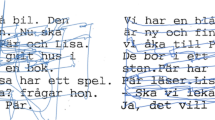Abstract
This article describes a method for detection of cognitive defects based on eye tracking during reading. The aim of this research is to pursue and extend the experiments conducted in Sweden by introducing Conventional signal theory. The dataset used for experiment was acquired by the authors of the research article Screening for Dyslexia Using Eye Tracking during Reading. The provided data consist of 185 subjects divided into two groups. The first group comprises of 88 low risk (LR) subjects and the second group comprises of 97 high risk (HR) subjects. Our measurements achieved a classification accuracy score 86.164% by classifying the subjects into the correct groups.
Access this chapter
Tax calculation will be finalised at checkout
Purchases are for personal use only
Similar content being viewed by others
References
Itti, L., Koch, C., Niebur, E.: A model of saliency-based visual attention for rapid scene analysis. IEEE Trans. Pattern Anal. Mach. Intell. 20(11), 1254–1259 (1998)
Polec, J., et al.: Detection of schizophrenia spectrum disorders using saliency maps. In: AICT 2017: 11th IEEE International Conference on Application of Information and Communication Technologies, Moscow, Russia, September 20–22, 2017, pp. 398–402. IEEE, Piscataway (2017)
Rello, L., Ballesteros, M.: Detecting readers with dyslexia using machine learning with eye tracking measures. In: W4A ‘15: Proceedings of the 12th Web for All Conference, International Web for All Conference Florence Italy May, 2015, Article No.: 16, pp. 1–8
Benfatto, M.N., Seimyr, G.Ö., Ygge, J., Pansell, T., Rydberg, A., Jacobson, C.: Screening for dyslexia using eye tracking during reading. PLoS ONE 11(12), e0165508 (2016)
Šikudová, E., Černeková, Z., Benešová, W., Haladová, Z., Kučerová, J.: Computer Vision Object Detection and Recognition. Wikina, Praha (2013)
Fraser, K.C., Fors, K.L., Kokkinakis, D., Nordlund, A.: An analysis of eye-movements during reading for detection of mild cognitive impairment. In: Proceedings of the 2017 Conference on Empirical Methods in Natural Language Processing, pp. 1016–1026
Yaneva, V., Ha, L.A., Eraslan, S., Yesilada, Y., Mitkova, R.: Detecting autism based on eye-tracking data from web searching tasks. In: W4A ‘18: Proceedings of the Internet of Accessible Things, The Internet of Accessible Things Lyon France, April 2018, Article No.: 16 , pp. 1–10
Acknowledgment
I would like to thank the authors for providing the dataset and information regarding the previous research Screening for Dyslexia Using Eye Tracking during Reading. Mattias Nilsson Benfatto, Gustaf Orqvist Seimyr, Jan Ygge, Ten Pansell, Agneta Rydberg, Christer Jacobson.
This research was supported by the VEGA 1/0440/19 research grant.
Author information
Authors and Affiliations
Corresponding author
Editor information
Editors and Affiliations
Rights and permissions
Copyright information
© 2022 Springer Nature Switzerland AG
About this paper
Cite this paper
Nerusil, B., Polec, J., Skunda, J. (2022). Fast Algorithm for Dyslexia Detection. In: Rozinaj, G., Vargic, R. (eds) Systems, Signals and Image Processing. IWSSIP 2021. Communications in Computer and Information Science, vol 1527. Springer, Cham. https://doi.org/10.1007/978-3-030-96878-6_14
Download citation
DOI: https://doi.org/10.1007/978-3-030-96878-6_14
Published:
Publisher Name: Springer, Cham
Print ISBN: 978-3-030-96877-9
Online ISBN: 978-3-030-96878-6
eBook Packages: Computer ScienceComputer Science (R0)




